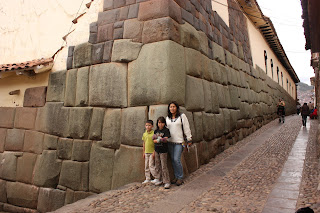












4-12 through 4-19-2010: We arrived in Cusco; a lovely, albeit, touristy city at an altitude of 11,200 feet. It had lots of plazas with fountains, lots of old churches, and remnants of Inca walls downtown.
On 4-12, we visited the Museo Inka which has the best collection of Inca artifacts in Cussco. It also gave a good background on Andean environment and history: the casa of antepasados (house of the ancestors) was interesting. Mummies were housed behind a display that had glass windows looking into the ‘house’ as well as eerie red lighting. We also saw indigenous people weaving textiles by hand using a wooden loom and an artist that crafted small sculptures and other objects using granite stone from the Machu Picchu area. One sculpture we liked especially showed the 3 worlds of the Inca; the condor which represented the spirit or future world, the puma which represented the present or physical world, and the serpent which represented the past or underworld.
FYI: Cusco has been continuously occupied for at least 2000 years and claims to be the oldest city in the Americas. Cusco has an altitude of 11,150 ft and is surrounded by even higher mountains. The Incas constructed the city in the shape of a giant puma.
(4-13 through 4-16-10) On 4-13, the family began a 4 day/3 night Lares Valley trek with a final destination of Machu Picchu. A private car drove us from Cusco, through Urubamba, Calca, and to Lares where we soaked in mineral hot springs and had lunch before beginning our hike. We hiked 8 km in 3-1/2 hours with a 1600 foot climb to our 1st camp at Huacahuasi.
The next day (day 2) we ascended 2000 ft to cross Paso Ipsaycocha (Ipsaycocha Pass) at an altitude of 14,400 feet (our highest point of the trek) then descended 2000 feet to our 2nd camp at Patacancha (the hike was 12 km and about 5-1/2 hrs). Our guide, Henri, had advised us before starting our trek to buy a couple packages of pencils since the indigenous kids flocked to the trail hoping to get ‘caramelos’ (candy) from the passing tourists, but pencils were a better option and more practical.
Day 3 involved a 5 hr, 12 km descent to the town of Ollantaytambo where we took a 1-1/2 hr train ride to the town of Aguas Caliente (town outside of Machu Picchu).
The next morning (day 4) a guide gave us an informative 2-1/2 hr tour in Spanish. We spent additional time exploring the ruins and walking to the Inca drawbridge; the trail hugged the cliffside with steep drop-offs. Luckily, the drop-offs were obscured by clouds (the weather was rainy and cloudy) and vegetation so the fear of heights factor wasn’t a problem. The architectural techniques and building designs of the Incas was spectacular.
Machu Picchu Facts: It is situated in the highland jungle at an altitude of 2432m (7972 feet). Th most common stone found in the region is grayish-white granite which contains high quantities of quartz, mica, and feldspar thus making it relatively easy to shape. Therefore, the rock was a magnificent building material for the Inca masons.
4-18-10: The family walked around Cusco looking at remnants of Inca walls, the architecture of colonial churches/cathedrals, remains of an Inca temple (Koricancha), and the polygonal stone walls of Hatunrumiyoc’s palace which has the famous 12-angled stone. In the neighborhood of San Blas, we stumbled upon the Museo de la Coca; a small, private museum dedicated to promoting knowledge and understanding of the Inca’s sacred leaf. We saw an interesting chart listing the numerous vitamins and minerals coca has along with its medicinal properties. Its use was also interwoven in all facets of the Inca lifestyle and its use and importance continues in the present day indigenous descendants of the Incas.















